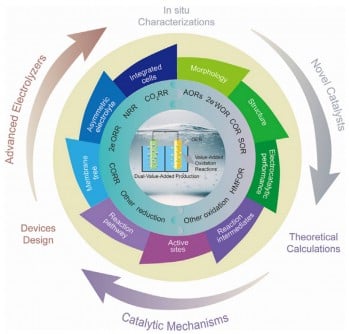Top Stories
Breakthrough in Electrolysis Promises Sustainable Energy Now

UPDATE: A groundbreaking review published by a collaborative research team from Jiangsu University, the Chinese Academy of Sciences, Hasselt University, and MIT is transforming the landscape of sustainable energy production. This comprehensive study, released in the journal eScience in July 2025, reveals innovative electrochemical systems that could significantly cut CO2 emissions and enhance the efficiency of energy production.
For over two centuries, fossil fuels have accounted for over 80% of global energy and chemical production, driving up CO2 emissions and contributing to climate change. With conventional chemical processes remaining carbon-intensive, there’s an urgent need for alternatives. The new research emphasizes the potential of integrating electrosynthesis systems that replace the inefficient oxygen evolution reaction (OER) with more effective oxidation reactions.
The authors detail how these systems can couple alternative oxidation reactions—like methanol, glycerol, and sulfide oxidation—with reduction processes such as CO2 and nitrogen conversion. This dual-output capability not only reduces energy consumption but also produces valuable by-products such as formic acid and hydrogen peroxide, making the technology both sustainable and economically viable.
Prof. Zhenhai Wen, a co-author of the study, states,
“Electrochemical systems that simultaneously produce two valuable outputs represent a paradigm shift for green chemistry.”
The integration of advanced catalysts, innovative electrolyzer architectures, and powerful characterization techniques provides unprecedented opportunities to design scalable, efficient processes.
Major advancements in catalyst development are central to this progress. Researchers are now utilizing nanostructured materials, including alloyed and defect-engineered catalysts, which enhance selectivity and expand active sites. The deployment of self-supported and gas-diffusion electrodes is further improving stability and conversion rates, paving the way for industrial-scale applications.
The study also highlights the evolution of electrolyzers from traditional H-type cells to cutting-edge flow cells and membrane electrode assemblies. These advancements are critical for achieving high current densities required for large-scale energy production.
In addition, the use of advanced in situ and operando techniques—such as infrared spectroscopy, Raman spectroscopy, and electron microscopy—enables direct monitoring of catalytic processes, optimizing reaction pathways. Coupled with computational methods like density functional theory (DFT) and machine learning, these innovations are accelerating the design of effective catalysts.
The implications of this dual-value electrosynthesis are vast. Beyond reducing carbon emissions, these systems promise cost-effective production of green hydrogen, fuels, and fertilizers, directly addressing climate and resource challenges. By pairing CO2 reduction with alcohol oxidation or waste remediation, researchers can generate both economic and ecological value.
Looking to the future, the combination of advanced catalysts, computational design, and industrial-scale electrolyzers could revolutionize chemical manufacturing. This strategy aligns with global net-zero ambitions, creating new opportunities for a renewable-driven industrial chemistry landscape.
As the world grapples with the urgent need for sustainable solutions, this research signifies a monumental step forward. The advancements reported in eScience not only highlight the potential for cleaner energy but also promise a more sustainable and resilient chemical industry.
Stay tuned for further developments as this story unfolds, and consider sharing this vital news to keep others informed about the future of sustainable energy.
-

 Health4 days ago
Health4 days agoRare Brain Condition Discovered More Common in New Mexico
-

 Politics5 days ago
Politics5 days agoPrince Andrew Steps Back from Royal Duties Following Epstein Memoir
-

 Health5 days ago
Health5 days agoRemembering Mary Ingleby: A Life of Love, Teaching, and Music
-

 Sports6 days ago
Sports6 days agoMLS Decision Day 2025: Playoff Spots on the Line as Teams Clash
-

 World5 days ago
World5 days agoYoung Driver Dies in Collision with Box Truck in El Cajon
-

 Science5 days ago
Science5 days agoIdaho State University Launches Haunted Science Laboratory on Oct. 25
-

 Lifestyle5 days ago
Lifestyle5 days agoKent Hamilton Named Southeastern Farmer of the Year at Expo
-

 Business5 days ago
Business5 days agoFirst National Bank of Groton’s Quiet Period Ends October 21
-

 Entertainment5 days ago
Entertainment5 days agoTrump Commutes George Santos’ Sentence, Sparks Controversy
-

 Politics5 days ago
Politics5 days agoNavy Veteran Max Quattromani Launches Campaign for Assessor Seat
-

 Sports5 days ago
Sports5 days agoSaquon Barkley Reacts to James Franklin’s Dismissal from Penn State
-

 Health5 days ago
Health5 days agoFDA Introduces First Nine Recipients of National Priority Vouchers









